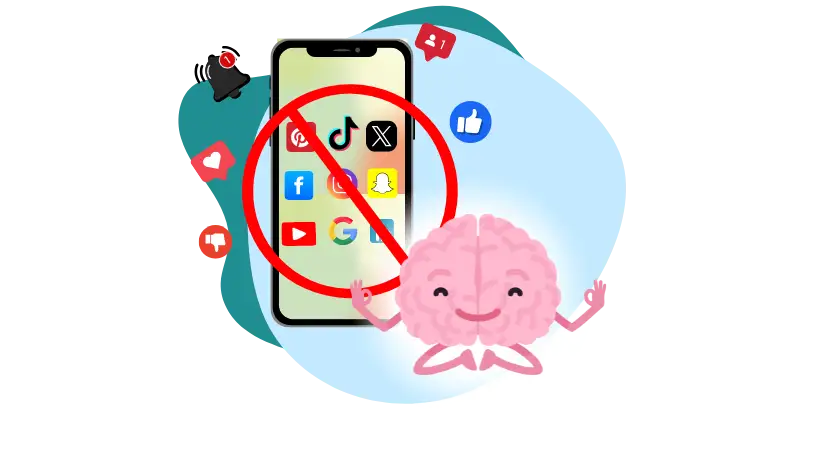The Digital Detox 2.0 – Dilemma of 2025
In the age of 2025, we find ourselves constantly tethered to screens—whether it’s for work, leisure, or even daily tasks. Technology has undeniably made life more convenient, but it has also led to a new crisis: screen time burnout. This issue is not only about eye strain but about deteriorating mental health, fragmented attention spans, and poor sleep quality.
Enter Digital Detox 2.0—the next evolution in reclaiming our well-being in an overly connected world. If you’ve been feeling mentally drained, emotionally exhausted, or easily distracted, this guide will walk you through effective strategies for Digital Detox 2.0 to reset your brain, improve focus, and regain balance.
Section 1: Why You Need Digital Detox 2.0 in 2025
The initial idea behind a digital detox was simple: unplug completely. However, with the increasing reliance on digital devices for work, communication, and even relaxation, this approach is no longer practical in 2025. Enter Digital Detox 2.0—a more sustainable and strategic approach.
Digital Detox 2.0 is not about going completely offline.
It’s about setting mindful boundaries with screen time.
It emphasizes brain recovery rather than just avoiding screens altogether.
Digital Detox 2.0 is about improving the way we interact with technology, not disconnecting entirely.
For a deeper dive into understanding the psychology behind technology use and the need for balance, check out The Psychology of Screen Time.
Section 2: How to Recognize Screen Time Burnout
Many people don’t realize they’re suffering from screen time burnout until it’s too late. Below are some signs you might need Digital Detox 2.0:
- Chronic fatigue despite sleeping
- Eye strain or frequent headaches
- Anxiety when away from your phone
- A shorter attention span, or habitually “doom-scrolling”
- Mental fog or lack of motivation
- Trouble falling or staying asleep
If any of these sound familiar, it’s time to implement Digital Detox 2.0 and reset your brain.
Section 3: How Excessive Screen Time Damages Your Brain
Let’s break it down scientifically: The human brain is not designed to process a constant stream of notifications, blue light, and fragmented digital content. Here’s how screen time harms your brain:
- Dopamine Overload: Apps, social media, and notifications continuously release dopamine, making you crave more stimulation. This reduces the enjoyment of offline activities.
- Cognitive Overload: Juggling multiple apps and notifications decreases your ability to focus, remember things, and make decisions.
- Sleep Disruption: Blue light from screens interferes with melatonin production, the sleep hormone, making it harder to rest.
- Increased Anxiety: Studies show that excessive screen use, especially social media, contributes to higher rates of anxiety and depression. For more information, explore this insightful study by the National Institute of Mental Health.
Implementing Digital Detox 2.0 can help reduce these effects and support mental wellness.
Section 4: The Power of a Brain Reset with Digital Detox 2.0
The goal of Digital Detox 2.0 is not to punish yourself by going cold turkey. Instead, it’s about providing your brain the opportunity to rest, recover, and restore balance. Benefits of Digital Detox 2.0 include:
- Enhanced focus and productivity
- Better quality of sleep
- Improved creativity
- Reduced stress and anxiety
- Reconnection with offline pleasures like hobbies, nature, and relationships
Here’s how you can begin implementing Digital Detox 2.0 for a clearer mind.
Section 5: 10 Digital Detox 2.0 Tips for a Healthier 2025
- Create ‘No-Screen Zones’
Designate areas in your home—like the bedroom or dining room—as screen-free spaces. This reinforces boundaries and encourages mindful offline time.
Pro Tip: Use a real alarm clock instead of relying on your phone.
- Schedule Tech-Free Hours
Set aside one hour a day, such as in the morning or just before bed, to completely disconnect from screens.
Example: Establish a “No Tech After 9 PM” rule.
- Track Screen Time
Both iOS and Android devices offer weekly reports of your screen time. Use these reports to identify time-wasting apps and create limits.
Goal: Aim to cut 10-20% of your non-essential screen time each week with Digital Detox 2.0.
- Replace Screen Time with Mindful Activities
Instead of simply reducing screen time, replace it with fulfilling activities such as:
- Journaling
- Reading physical books
- Meditation or yoga
- Cooking or drawing
- Single-Tasking Over Multitasking
Multitasking may seem efficient, but it reduces your ability to focus. Practice single-tasking for better brain performance.
- Use Grayscale Mode
Set your phone to grayscale to remove the stimulating colors that encourage app addiction. This can help reduce screen usage.
- Batch Notifications
Turn off unnecessary push notifications and check apps in batches—say, three times a day.
- Go Analog with a Physical Journal
Swap your digital notes for a traditional paper journal or planner. This encourages mindfulness and reduces screen reliance.
- Try a “Digital Sabbath”
Take one day each week (like Sunday) to be tech-free. This sacred time can help recharge your emotional and mental batteries.
- Use Technology to Support Your Detox
Ironically, some apps can help you detox. Try these:
- Forest – Helps you stay focused by growing a virtual tree while you work.
- Freedom – Blocks distracting apps on all devices.
- Headspace – Provides guided meditations to improve mindfulness and sleep.
Section 6: Digital Detox 2.0 at Work—Yes, It’s Possible
You may think, “But I need screens for work!” Here’s how you can detox while still being productive:
- Pomodoro Technique: Work for 25 minutes, then take a 5-minute break (without screens!).
- Walking Meetings: Take calls or meetings while walking outside.
- Inbox Intervals: Limit email checking to 3-4 times a day, rather than constantly.
- Blue Light Glasses: These help reduce eye strain and support melatonin production.
Digital Detox 2.0 can make your workday more productive and less stressful.
Section 7: What Happens After 7 Days of Digital Detox 2.0?
Many people report positive changes even after one week of Digital Detox 2.0:
- Increased attention span and creativity
- A feeling of calm and emotional balance
- Better emotional regulation
- Rediscovering enjoyment in offline activities
The benefits of Digital Detox 2.0 continue to grow with time and consistency.
Section 8: Digital Detox 2.0 for Families and Kids
The digital age affects children more than ever before. Parents can model healthy digital habits by:
- Setting a “Tech Basket” during meals
- Planning screen-free family activities like hiking or board games
- Encouraging creative activities like art or sports
- Using parental control tools to set boundaries
Implementing Digital Detox 2.0 for families fosters real-world connections and healthy tech habits.
Section 9: The Future of Digital Wellness
Looking ahead, Digital Detox 2.0 will become a routine part of our daily lives, just like exercise or a balanced diet. Here’s what we can expect in the future:
- Digital wellness courses in schools
- Mindful tech certifications in workplaces
- Healthcare providers recommending detox plans
- Wearables that monitor screen fatigue
For further reading on digital health trends, check out this article on AR Glasses vs. Smartphones in 2025.
Conclusion: Resetting for Real Clarity with Digital Detox 2.0
You don’t have to quit technology to reclaim your mind. Digital Detox 2.0 is about balance, mindfulness, and conscious use. By incorporating these simple yet effective tips, you can avoid screen time burnout and achieve lasting mental clarity.
Take a deep breath, log off, and give yourself the chance to reset. Your brain—and your life—will thank you.
Quick Summary Checklist
- Set no-screen zones in your home
- Use screen time tracking and grayscale mode
- Replace scrolling with mindfulness
- Batch notifications and emails
- Try one tech-free day a week
- Prioritize sleep and blue-light limits
- Start small—1 hour a day is enough to begin with Digital Detox 2.0



